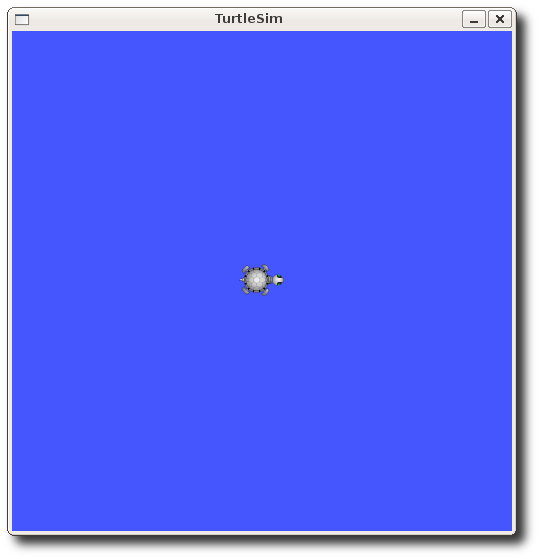| Note: This tutorial assumes that you have completed the previous tutorials: Gerando um pacote no ROS. |
| |
Um pouco mais sobre nós(''nodes'') no ROS
Description: Este tutorial apresenta os conceitos introdutórios sobre os componentes básicos do ROS (também referenciados como ROS Graph) e discute o uso das ferramentas utilizadas via terminal: roscore, rosnode e rosrun.Tutorial Level: BEGINNER
Next Tutorial: Entendendo tópicos no ROS
Contents
Pré-requisitos
Nesse tutorial, utilizaremos um simulador relativamente simples, para isso é necessário a instalação das seguintes dependências:
$ sudo apt-get install ros-<distro>-ros-tutorials
Sendo que '<distro>' deve ser substituído pela sua atual distribuição do ROS (hydro, groovy, electric, fuerte, kinetic, lunar ou morenia)
Rápida Revisão Sobre Conceitos do ROS
Nó: Um nó(node) consiste em um executável (aplicação gerada por meio de um código fonte) que utiliza o ROS para realizar a comunicação com outros nó(node).
Menssagens: Tipos de dados no ROS usados quando se publica ou sobrescreve de tópico.
Tópicos: Nós(node) podem publicar menssagens em tópicos assim como podem subescrever menssagens de tópicos.
Master: Service de gerenciamento do sistema do ROS (ex: ajuda os nós a se encontrarem no sistema.)
rosout: Equivalente do ROS ao stdout/stderr
roscore: Comando para inicializar o Master + rosout + servidor de parâmetros (o conceito de servidos de parâmetros será explicado posteriormente). É um dos comandos para inializar o "sistema" do ROS.
Nós(''node'')
Um nó(node) na verdade é apenas um arquivo executável dentro de um pacote do ROS. Nós(node) no ROS usam bibliotecas clientes (client librarys) para se comunicar com outros nós(node). Nós(node) podem publicar e/ou subscrever em tópicos, além de poderem prover serviços(services) também.
Bibliotecas Clientes (''client librarys)
ROS client libraries allow nodes written in different programming languages to communicate:
- rospy = python client library
- roscpp = c++ client library
roscore
roscore is the first thing you should run when using ROS.
Please run:
$ roscore
You will see something similar to:
... logging to ~/.ros/log/9cf88ce4-b14d-11df-8a75-00251148e8cf/roslaunch-machine_name-13039.log Checking log directory for disk usage. This may take awhile. Press Ctrl-C to interrupt Done checking log file disk usage. Usage is <1GB. started roslaunch server http://machine_name:33919/ ros_comm version 1.4.7 SUMMARY ======== PARAMETERS * /rosversion * /rosdistro NODES auto-starting new master process[master]: started with pid [13054] ROS_MASTER_URI=http://machine_name:11311/ setting /run_id to 9cf88ce4-b14d-11df-8a75-00251148e8cf process[rosout-1]: started with pid [13067] started core service [/rosout]
If roscore does not initialize, you probably have a network configuration issue. See Network Setup - Single Machine Configuration
If roscore does not initialize and sends a message about lack of permissions, probably the ~/.ros folder is owned by root, change recursively the ownership of that folder with:
$ sudo chown -R <your_username> ~/.ros
Using rosnode
Open up a new terminal, and let's use rosnode to see what running roscore did...
Note: When opening a new terminal your environment is reset and your ~/.bashrc file is sourced. If you have trouble running commands like rosnode then you might need to add some environment setup files to your ~/.bashrc or manually re-source them.
rosnode displays information about the ROS nodes that are currently running. The rosnode list command lists these active nodes:
$ rosnode list
- You will see:
/rosout
This showed us that there is only one node running: rosout. This is always running as it collects and logs nodes' debugging output.
The rosnode info command returns information about a specific node.
$ rosnode info /rosout
This gave us some more information about rosout, such as the fact that it publishes /rosout_agg.
------------------------------------------------------------------------ Node [/rosout] Publications: * /rosout_agg [rosgraph_msgs/Log] Subscriptions: * /rosout [unknown type] Services: * /rosout/set_logger_level * /rosout/get_loggers contacting node http://machine_name:54614/ ... Pid: 5092
Now, let's see some more nodes. For this, we're going to use rosrun to bring up another node.
Using rosrun
rosrun allows you to use the package name to directly run a node within a package (without having to know the package path).
Usage:
$ rosrun [package_name] [node_name]
So now we can run the turtlesim_node in the turtlesim package.
Then, in a new terminal:
$ rosrun turtlesim turtlesim_node
You will see the turtlesim window:
NOTE: The turtle may look different in your turtlesim window. Don't worry about it - there are many types of turtle and yours is a surprise!
In a new terminal:
$ rosnode list
You will see something similar to:
/rosout /turtlesim
One powerful feature of ROS is that you can reassign Names from the command-line.
Close the turtlesim window to stop the node (or go back to the rosrun turtlesim terminal and use ctrl-C). Now let's re-run it, but this time use a Remapping Argument to change the node's name:
$ rosrun turtlesim turtlesim_node __name:=my_turtle
Now, if we go back and use rosnode list:
$ rosnode list
- You will see something similar to:
/rosout /my_turtle
Note: If you still see /turtlesim in the list, it might mean that you stopped the node in the terminal using ctrl-C instead of closing the window, or that you don't have the $ROS_HOSTNAME environment variable defined as described in Network Setup - Single Machine Configuration. You can try cleaning the rosnode list with: $ rosnode cleanup
We see our new /my_turtle node. Let's use another rosnode command, ping, to test that it's up:
$ rosnode ping my_turtle
rosnode: node is [/my_turtle] pinging /my_turtle with a timeout of 3.0s xmlrpc reply from http://aqy:42235/ time=1.152992ms xmlrpc reply from http://aqy:42235/ time=1.120090ms xmlrpc reply from http://aqy:42235/ time=1.700878ms xmlrpc reply from http://aqy:42235/ time=1.127958ms
Review
What was covered:
- roscore = ros+core : master (provides name service for ROS) + rosout (stdout/stderr) + parameter server (parameter server will be introduced later)
- rosnode = ros+node : ROS tool to get information about a node.
- rosrun = ros+run : runs a node from a given package.
Now that you understand how ROS nodes work, let's look at how ROS topics work. Also, feel free to press Ctrl-C to stop turtlesim_node.








